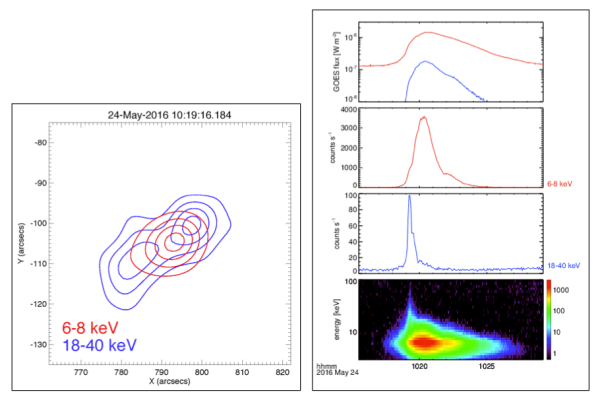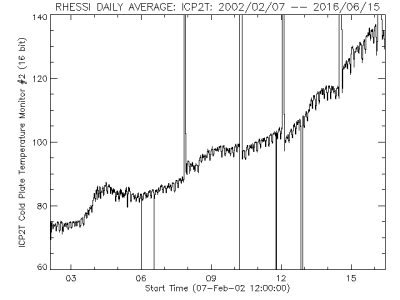RHESSI has resumed operations
| Nugget | |
|---|---|
| Number: | 276 |
| 1st Author: | Brian Dennis, |
| 2nd Author: | Säm Krucker and Albert Shih |
| Published: | 20 June 2016 |
| Next Nugget: | TBD |
| Previous Nugget: | Non-thermal free-bound emission |
Introduction
As described in Nugget 269, RHESSI began its 5th anneal cycle on February 23. The annealing process involves raising RHESSI's detectors to an elevated temperature, during which the crystal structure can realign itself and erase dislocations produced by high-energy particle interactions. The data flow ceased during the annealing operation, but again the instrument was restored to health, and routine observations have resumed in a slightly modified operational scheme. Figure 1 shows images of SOL2016-05-24T10:20 (C1.3), illustrating RHESSI's essential capability for hard X-ray imaging spectroscopy.

Another example in the quicklook Browser service confirms RHESSI's sensitivity to a weaker event: SOL2016-06-09 (B3.0). This is a nice microflare with type III radio emission.
Functionality
As the cryocooler ages, the operating temperatures of the detectors have continued to increase very slowly. Figure 2 shows this via a routine engineering plot, showing a key temperature value over the full life of RHESSI thus far. The temperature increase presumably results from the normal ageing of the cryocooler, and we expect it to continue indefinitely into the future.

The temperatures are approaching the point where some detectors lose segmentation. If this happens they will not function so well as gamma-ray spectrometers, because the anticoincidence between independent front and rear segments will no longer be possible, and the background counting rate will increase substantially. Even without detector segmentation, though, we expect that RHESSI will still perform its core function of hard hard X-ray imaging spectroscopy.
To postpone the loss of segmentation, specifically to be able to observe the last few gamma-ray flares of Cycle 24, we we now plan to operate RHESSI in a low-power mode. Since the detector amplifiers dissipate some tiny amounts of heat in the cryocooler, turning some of them off can decrease the rate of temperature increase. Thus we now plan to keep all but two of the detectors switched off except during times of high solar activity and for special support activities. For example, at the time of writing, we are operating Detectors 3 and 8. As shown in Figure 1, this still allows us to obtain hard X-ray images, time series, and spectra as before, but the images have less (u,v)-plane coverage. Users of RHESSI observations from this point on should be aware that for most of the time with low and moderate solar activity only two detectors may be operating.
In our new operating scheme, the full complement of detectors will be turned on at times of exceptionally high activity, or to support specific observing campaigns. These might include the first solar observations with the ALMA radio telescope, possibly to be scheduled for a week or two at the end of 2016 or beginning of 2017.
The future
RHESSI has returned successfully from its fifth annealing operation and we are now obtaining data in a slightly different mode. This involves using a reduced detector set to improve the temperature performance in the hopes of retaining full functionality for X-class flare observations in any final major activity of Cycle 24. At present we are operating detectors 3 and 8, for example, and find these to be sufficient for the core mission of hard X-ray imaging spectroscopy.